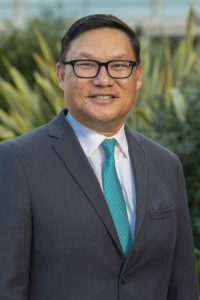
At its very essence, says Vascular & Endovascular Surgery Society (VESS) President Jason T. Lee, MD, vascular surgery is a “social sport.” The specialty is built on the backs of not just the “alpha point guard,” or the surgeon, but burgeoning teams of nurses, hospitalists, trainees and administrative support staff as well. It’s that very notion of vascular surgery as a team sport that typifies just how important it is to get back live in a room together to share the collected wisdom of vascular surgical science, Lee tells Vascular Connections, as he looks ahead to the VESS Spring Meeting at the Vascular Annual Meeting (VAM).
“The care that should be delivered to our vascular patients has to be from a team-oriented approach,” he tells Vascular Connections. “At meetings such as VAM, the collective knowledge, energy and science brought forth is so wide-ranging and diverse that it becomes the ultimate arena for vascular surgery discussions. Meeting stakeholders all want attendees to go home to impact vascular care in their community based on new things learned while attending VAM. This is particularly important for the younger vascular surgeon, and opportunities within VESS help catapult earlier involvement in this. VAM is an opportunity to highlight the teamwork necessary for cutting-edge projects, science and clinical care.”
In a departure from previous iterations of VAM, the VESS session will be in the main plenary hall on Wednesday afternoon, featuring 26 presentations—17 of which are full-length papers—covering the breadth of vascular surgical practice. “What the pandemic taught us last year about vascular surgery academics— the collegiality, collaboration and education we gain by traveling in person to VAM and other national meetings—was that we lost a little bit of that in the virtual world,” Lee says. “I think virtual meetings were the best we could do at the time, but nothing beats the camaraderie and exchange of ideas that happen in person.”
As such, the VESS program delves into complex aortic outcomes, lower-extremity limb salvage, risk stratification, carotid interventions and stroke risk across a range of presentation styles, with research derived from big data, single centers, multicenter collaboratives and surveys. “The agenda represents the whole range of our specialty, through a lot of the most challenging end-stage problems our patients face, including peripheral arterial disease [PAD], dialysis and trauma,” Lee says. “So, I think the program really mirrors the purpose of VAM in a teamwork-focused, high-impact event that has something for everyone in our specialty. We’ve gone out of our way to select papers we think will be interesting to all vascular surgeons and be able to increase knowledge.
“The other thing we’ve done, which is very purposeful, is to go out of our way for the papers that were selected to be from a wide variety of programs across the country. We’ve also invited discussants for the papers from places that are not already otherwise represented at VAM, and further focused on the young vascular surgeon in practice or nearing the end of training.” VESS Councilor-at-Large Shang Loh, MD, clinical associate professor and vascular surgery program director at Stony Brook University Medical Center in New York, will co-moderate the session along with Lee and a string of colleagues. He describes the VESS portion as “not secondary” to VAM “but complementary,” drawing attention to two representative papers showcasing the full-circle nature of VESS’ emphasis on trainees and early-career surgeons.
Aortic dissection flap morphology
Kelsi K. Hirai MD, a fourth-year general surgery resident at Stony Brook University Medical Center who just matched into a vascular fellowship position at Oregon Health and Sciences University in Portland, is set to deliver findings on behalf of a research team mentored by Loh himself, showing that “straight flap morphology is more common than spiral configurations and appears to cause larger false lumens with more true lumen compression.” Straight dissections overwhelmingly dissect along the greater curve of zone 3 while spirals typically begin in zone 4 or 5 of the descending thoracic aorta, Hirai and colleagues found.
“Visceral involvement is more common in spiral dissections. Initial shape of the dissection flap may have implications for aortic remodeling and decisions regarding early intervention,” Hirai will tell the VESS session. “If you look at the literature, this hasn’t previously been studied from this perspective,” Loh says of the research. “What we’re doing is trying to identify some of the morphologic characteristics and how they may offer some insights into the nature, and, hopefully at some point in the future, the long-term prognosis and evolution of aortic dissection based on how they tear.”
TCAR and balloon dilation
Loh also points to the paper, “Balloon dilation strategy does not affect outcomes for transcarotid artery revascularization (TCAR) in prospective trials.” TCAR is a hot topic at the moment, Loh says. “Those of us who have done it since the inception have great experience in the procedure, but others are actively interested in exploring it.”
This paper slots in as a keen point of interest at this juncture, Loh points out, investigating the strategies of balloon dilation carried out during transfemoral carotid artery stenting—pre-stent dilation only, post-stent dilation only, or both—and the concerns raised over higher neurological risk with the latter two dilation strategies.
That may not be applicable to TCAR, which utilizes cerebral blood flow reversal during stent deployment and balloon angioplasty, posited presenting author Jones P. Thomas, MD, and colleagues. Jones, an integrated vascular surgery resident at University Hospitals Case Medical Center in Cleveland, Ohio, and his fellow researchers set out to analyze outcomes of the three balloon dilation strategies during TCAR.
“Based on these prospective trial data, there is no difference in neurological complications due to balloon dilation strategy during TCAR,” Thomas will tell VESS. “Balloon dilation technique best suited to the patient’s specific lesion should be utilized. Further studies are needed to evaluate the relationship of these dilation strategies to long-term outcome, including restenosis.”
When: Wednesday, Aug. 18, 12:45 p.m.–6:30 p.m. VESS Paper Session












